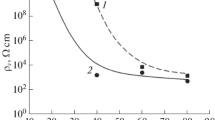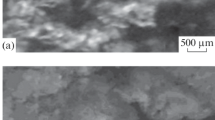Abstract
The burning of polyethylene in the mixture with aluminium hydroxide, aluminium oxide, cellulose and Irganox 1010 has been examined by cone calorimeter under non-standard sizes of the sample. The time to ignition of pure polyethylene decreases with decreasing initial amount of polyethylene powder. The subtraction of the mass of water released from the total mass lost for polyethylene with aluminium hydroxide give the same values of effective heats of combustion as for pure polyethylene up to the load about 50 mass% of aluminium hydroxide. The mean heats of combustion determined from the cone calorimeter software are higher than those determined from the total oxygen consumed and mass lost multiplied by the factor 13.1. The additivity rule was found for effective heat of combustion and total smoke released for polyethylene with cellulose. The free radical scavenger Irganox 1010 does not show a significant effect on the flammability of polyethylene except for the increase of the total smoke released. The equation describing the heat release rate evolution in time has been proposed showing a good fit to the experimental runs.










Similar content being viewed by others
References
Babrauskas V. Development of the cone calorimeter—A bench-scale heat release rate apparatus based on oxygen consumption. Fire Mater. 1984;8:81–95.
Babrauskas V, Peacock RD. Heat release rate: the single most important variable in fire hazard. Fire Saf J. 1992;18:255–72.
Huggett C. Estimation of rate of heat release by means of oxygen consumption measurements. Fire Mater. 1980;4:61–5.
Nussbaum RM, Östman BA-L. Larger specimen for determining rate of heat release in the cone calorimeter. Fire Mater. 1986;10:151–60.
Redfern JP. Rate of heat release measurement using the cone calorimeter. J Therm Anal Calorim. 1989;35:1861–77.
Janssens M. Piloted ignition of wood a review. Fire Mater. 1991;15:151–67.
Babrauskas V. Related quantities (a) heat of combustion and potential heat. In: Babrauskas V, Grayson SJ editors. Heat Release in Fires, Chapter 8. London: E & FN Spon (Chapman & Hall); 1996.
ISO 5660-1:2002. Reaction-to-fire tests—Heat release, smoke production and mass loss rate—Part 1: heat release rate (cone calorimeter method).
ISO 5660-2:2002. Reaction-to-fire tests—Heat release, smoke production and mass loss rate—Part 2: smoke production rate (dynamic measurement).
ISO/TR 5660-3:2003. Reaction-to-fire tests—Heat release, smoke production and mass loss rate—Part 3: guidance on measurement.
Schartel B, Bartholmai M, Knoll U. Some comments on the use of cone calorimeter data. Polym Degrad Stab. 2005;88:540–7.
Schartel B, Hull TR. Development of fire-retarded materials—Interpretation of cone calorimeter data. Fire Mater. 2007;31:327–54.
Staggs JEJ, Whiteley RH. Modelling the combustion of solid-phase fuels in cone calorimeter experiments. Fire Mater. 1999;23:63–9.
Patel P, Hull TR, Stec AA, Lyon RE. Influence of physical properties on polymer flammability in the cone calorimeter. Polym Adv Technol. 2011;22:1100–7.
Hull TR, Price D, Liu Y, Wills CL, Brady J. An investigation into the decomposition and burning behaviour of EVA copolymer nanocomposites. Polym Degrad Stab. 2003;82:365–71.
Xu Q, Majlingova A, Zachar M, Jin C, Jiang Y. Correlation analysis of cone calorimetry test data assessment of the procedure with tests of different polymers. J Therm Anal Calorim. 2012;110:65–70.
Tsai K-C. Using cone calorimeter data for the prediction of upward flame spread rate. J Therm Anal Calorim. 2013;112:1601–6.
Janowska G, Kucharska-Jastrzabek A, Rybinski P. Thermal stability, flammability and fire hazard of butadiene–acrylonitrile rubber nanocomposites. J Therm Anal Calorim. 2011;103:1039–46.
Lindholm J, Brink A, Hupa M. The influence of decreased sample size on cone calorimeter results. Fire Mater. 2012;36:63–73.
Rychlý J, Rychlá L, Csomorová K. Characterisation of materials burning by a cone calorimeter: 1. Pure polymers. J Mater Sci Eng. 2012;A2:174–82.
Dorigato A, Pegoretti A, Frache A. Thermal stability of high density polyethylene–fumed silica nanocomposites. J Therm Anal Calorim. 2012;109:863–73.
Hull TR, Witkowski A, Hollinbery L. Fire retardant action of mineral fillers. Polym Degrad Stab. 2011;96:1462–9.
Zarringhalam A, Saedi G. Fire retardation of polymers. Scientia Iranica. 2000;7:125–8.
Zarringhalam A, Rezaic MR, Mehrabzadeh M. Combustibility of polypropylene. Iran Polym J. 1997;6:121–6.
Acknowledgements
This publication is the result of the project implementation: Centre for materials, layers and systems for applications and chemical processes under extreme conditions. Part II supported by the Research & Development Operational Programme funded by the ERDF.
Author information
Authors and Affiliations
Corresponding author
Rights and permissions
About this article
Cite this article
Rychlý, J., Hudáková, M. & Rychlá, L. Burning of thermally thin polyethylene mixtures. J Therm Anal Calorim 115, 527–535 (2014). https://doi.org/10.1007/s10973-013-3305-y
Received:
Accepted:
Published:
Issue Date:
DOI: https://doi.org/10.1007/s10973-013-3305-y




